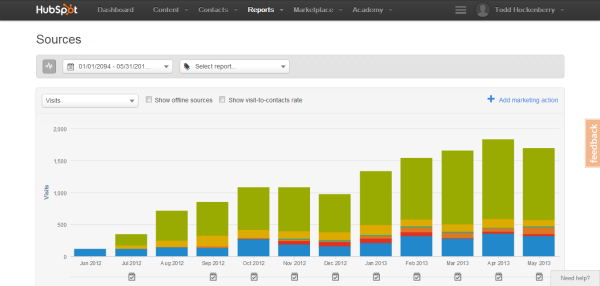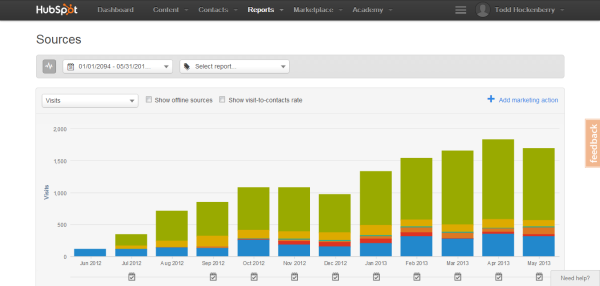 Take an awesome product like HubSpot and mix in some experience and expertise from the amazing HubSpot marketing agency community and what do you get? Hopefully a lot of value added service that helps the client achieve their goals. Easy enough to say, but what are your client's goals? Of course we spend most of our time talking about site visits, leads, and sales. Pretty obvious that these are all crucial components of successful Inbound Marketing. If you are not delivering on these basics then you probably will not be keeping your clients long or landing many new ones. But that is not the entire story, there are other critical area of value creation that HubSpot Agency Partners can impact.
Take an awesome product like HubSpot and mix in some experience and expertise from the amazing HubSpot marketing agency community and what do you get? Hopefully a lot of value added service that helps the client achieve their goals. Easy enough to say, but what are your client's goals? Of course we spend most of our time talking about site visits, leads, and sales. Pretty obvious that these are all crucial components of successful Inbound Marketing. If you are not delivering on these basics then you probably will not be keeping your clients long or landing many new ones. But that is not the entire story, there are other critical area of value creation that HubSpot Agency Partners can impact.
So how can HubSpot agency partners create more value?
First, you need to understand what your clients are looking for. Of course your clients want more leads and increased sales, but what else are they looking for?
We had a manufacturing client which was a small division of a much larger company. Our client had great potential for growth, but their internal sales team generated all of their leads. They had no external sales network, no marketing budget, no internal marketing or inbound expertise, and their website did not generate any leads for them. Of course our client wanted to generate more leads and sales, but their stagnant growth was impacting other areas as well.
This company was in a situation where they might have to let some of their highly trained and experienced personnel go. They knew that they would probably have the work to hire back any staff they let go later in the year, but there was no guarantee that the staff would still be available so they might have to replace them with less skilled employees.
The client knew they needed more sales and leads, but more than that they also needed a way to decrease employee turnover. And, because we were able to help them increase their sales, we were able to help them keep their employees. We identified this value area during our qualification calls and made this an area of cost savings that was atrtributed to our work. We came to agreement on the value of retaining these employees and the resulting savings.
This is just one example of how agency partners can create value for their clients above and beyond simple increased leads and sales.
You need to figure out the consequences and implications of the obvious value you provide, and then assign a dollar value to those areas because you should be getting paid for your value. From decreased costs to a faster sales cycle, agencies have a lot of areas they can positively affect in terms of generating measurable return for their clients.
Reducing the marketing customer cost of acquisition, or COCA, is one of the primary ways in which a agency can deliver value for its clients. Reducing the COCA should be one one of the big ticket items for agencies. If you can lower the cost of customer acquisition, it frees up more resources to attract more customers – in other words making the marketing and sales function more efficient as well as more effective.
There are a lot of other areas where agencies can add value. Check out the list below and leave a comment if you can think of any others.
- Increased revenues or profitability
- Faster time to market
- Decreased marketing costs
- Improved operational efficiency
- Revitalizing the organization
- Enhancing customer loyalty
- Increased market share
- Decreased employee turnover
- Attracting better employees, partners, vendors, investors
- Improved customer retention levels
- Increased revenue per customer
- Increased competitive differentiation
- Faster response time
- Decreased operational expenses
- Increased sales per customer
- Improved asset utilization
- Faster collections
- Minimize sales and marketing risk
- Additional revenue streams
- Improved time-to-profitability
- Increased billable hours
- Increased inventory turns
- Faster sales cycles
During the recent partner day at HubSpot, I was part of a presentation about value-based fees, or getting paid for the results you deliver and not just the tasks you do (or heaven forbid the hours you work).
Here is a before and after example from an actual client of ours. We agreed on these areas and levels of value BEFORE we signed a retainer agreement:
|
Area of Value – projected year one |
Value |
|
Revenue for existing products |
$600,000 |
|
Revenue from expanded sales network |
$100,000 |
|
Lower COCA (decrease by 10%) – increase margins |
$50,000 |
|
Revenue from new products |
$250,000 |
|
Maintain work force |
$50,000 |
|
Internal promotion |
$50,000 |
|
Increase existing lead conversion (improve close rate by 20%) |
$100,000 |
|
Internal branding/Thought leadership |
$100,000 |
|
Total Value |
$1,400,000 |
Here is the ACTUAL value delivered in year one.
|
Area of Value – after year one |
Value |
|
Revenue for existing products |
$650,000 |
|
Revenue from expanded sales network |
$125,000 |
|
Lower COCA (decrease by 10%) – increase margins |
$50,000 |
|
Revenue from new products |
$150,000 |
|
Maintain work force |
$25,000 |
|
Internal promotion |
$50,000 |
|
Increase existing lead conversion (improve close rate by 20%) |
$100,000 |
|
Internal branding/Thought leadership |
$50,000 |
|
Total Resulting Value |
$1,200,000 |
|
Total Fees |
$65,000 |
|
ROI |
18X |
This is a happy client. Make sure you identify all of the areas of value creation and maximize the real ROI for your services and for Inbound Marketing and get paid for it.


 In July of 2012 we began working with a company that designs and manufactures custom fiberglass pipe, large diameter fiberglass ductwork, fiberglass tanks, fiberglass vessels, other equipment and services relating to fiberglass products. This company is a subsidiary of a larger parent company, and for a number of years was content to supply cooling tower components for the parent company's projects. We began working with them because they felt it was time to branch out and had turned to HubSpot and inbound marketing to help them reach new markets.
In July of 2012 we began working with a company that designs and manufactures custom fiberglass pipe, large diameter fiberglass ductwork, fiberglass tanks, fiberglass vessels, other equipment and services relating to fiberglass products. This company is a subsidiary of a larger parent company, and for a number of years was content to supply cooling tower components for the parent company's projects. We began working with them because they felt it was time to branch out and had turned to HubSpot and inbound marketing to help them reach new markets. You don't want your prospects to need these to make your site experience better!
You don't want your prospects to need these to make your site experience better!

 We've been HubSpot partners for over three years now and have on boarded over 40 customers as well as consulted with a few dozen others. But something happened today that has never happened to me before—I got a rousing round of applause from a client.
We've been HubSpot partners for over three years now and have on boarded over 40 customers as well as consulted with a few dozen others. But something happened today that has never happened to me before—I got a rousing round of applause from a client.  When was the last time you went to a trade show? If you're like most of my agency’s clients, you've been to a trade show sometime in the last year or two. What was your trade show experience like? Did it involve a lot of standing around the booth hoping someone would make accidental eye contact and feel guilty enough to come over and talk to you? How did you prep for the show? Did you spend a lot of time on having promo material ready, getting your backdrop just so, and filling your toolkit?
When was the last time you went to a trade show? If you're like most of my agency’s clients, you've been to a trade show sometime in the last year or two. What was your trade show experience like? Did it involve a lot of standing around the booth hoping someone would make accidental eye contact and feel guilty enough to come over and talk to you? How did you prep for the show? Did you spend a lot of time on having promo material ready, getting your backdrop just so, and filling your toolkit? Once you've got your salespeople to come around to the idea of inbound marketing, what do you do with their content ideas? If your salespeople followed the "
Once you've got your salespeople to come around to the idea of inbound marketing, what do you do with their content ideas? If your salespeople followed the "